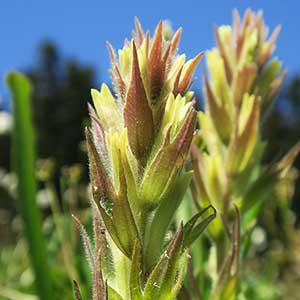Castilleja cryptantha
Castilleja latifolia
Mt. Rainier or obscure paintbrush, obscure Indian paintbrush, obscure paintbrush
Monterey coast paintbrush, Monterey Indian paintbrush, Monterey paintbrush, seaside paintbrush
few to several, erect or ascending, unbranched, hairs spreading, long, soft, eglandular, mixed with short stipitate-glandular ones.
many, spreading to erect, much-branched, with numerous short, leafy axillary shoots, hairs moderately dense, spreading, medium length to long, stiff to soft, shorter stipitate-glandular ones.
green, often with brown or purple veins, narrowly to broadly lanceolate, 1.5–4 cm, not fleshy, margins plane, ± involute, 0–3-lobed, apex acute to acuminate;
lobes spreading-ascending, narrowly lanceolate, apex acute to ± obtuse.
gray-green becoming ± purple to sometimes green as hairs are lost, oblong to lanceolate-oblong or broadly lanceolate, 0.5–2 cm, ± fleshy, cupulate, sometimes obscurely so on distal portion of stem, margins plane, sometimes ± wavy, involute, 0–3-lobed, apex truncate or broadly rounded to obtuse;
lobes erect to ascending, oblong, apex rounded.
(2.5–)3–6 × 1–2 cm; green to dull brown or dull reddish purple throughout, or proximally green to dull brown or dull reddish purple, distally yellow on apices, broadly lanceolate to ovate, (0–)3-lobed;
lobes ascending, narrowly lanceolate, long or short, arising near mid length, apex acute or acuminate.
2.5–20 × 1.5–5 cm;
bracts proximally green to dull, deep brownish purple, distally bright red, red-orange, or orange, sometimes yellow to yellow-orange, oblong or broadly lanceolate to widely obovate or ovate, often cup-shaped, center lobe often expanded distally, 0–3(–5)-lobed, often wavy-margined;
lobes ascending, oblong, short or long, arising near or above mid length, central lobe apex mostly rounded to truncate, sometimes with 5 or so very shallow teeth.
straight, 14–16 mm;
tube 11–14 mm;
whole corolla included within calyx;
beak adaxially pale yellow, 1–2 mm;
abaxial lip deep green, slightly inflated, 4–5 mm, 67% as long as beak;
teeth ascending, pale, 1.5–2 mm.
slightly curved, 19–30 mm;
tube 8.5–15 mm;
beak exserted, adaxially green, 8.5–15 mm;
abaxial lip ascending, deep green, reduced, 0.5–1 mm, 5–10% as long as beak;
teeth incurved, reduced, green or white, 0.2–0.5 mm.
proximally green or pale with green veins, lobes yellow, sometimes becoming deep red with age, 12–15 mm;
abaxial and adaxial clefts 3–7 mm, 25–50% of calyx length, deeper than laterals, lateral 1–3(–4) mm, 8–20% of calyx length;
lobes triangular, adaxial segments longer than abaxials, apex acute or obtuse.
proximally light green to sometimes purple, distally colored as bracts, 15–25 mm;
abaxial and adaxial clefts 6–9.5 mm, 33–50% of calyx length, deeper than laterals, lateral 1–3 mm, ca. 12% of calyx length;
lobes broadly triangular to oblong, apex rounded to obtuse, rarely acute.
= 24.
= 24.
Castilleja cryptantha
Castilleja latifolia
Castilleja cryptantha is endemic to the vicinity of Mt. Rainier in the Cascade Range, with most populations found within Mt. Rainier National Park. Unlike most species of Castilleja, it is apparently self-pollinating (W. J. Duffield 1972); the small flowers are entirely enclosed within the yellowish calyces, which tend to grow deep reddish as they age. The purplish brown bracts are also unusual in the genus.
(Discussion copyrighted by Flora of North America; reprinted with permission.)
Castilleja latifolia is endemic to the central California coast, especially around Monterey Bay. Around Half Moon Bay in San Mateo County, it apparently forms hybrids with C. affinis var. affinis. Records of this species from north of San Francisco and south of Monterey County are referable to other species.
(Discussion copyrighted by Flora of North America; reprinted with permission.)


